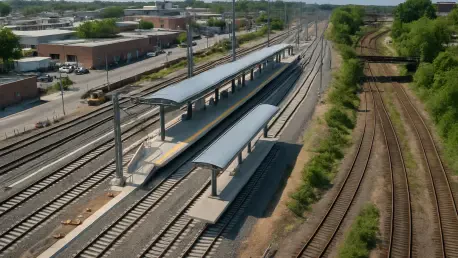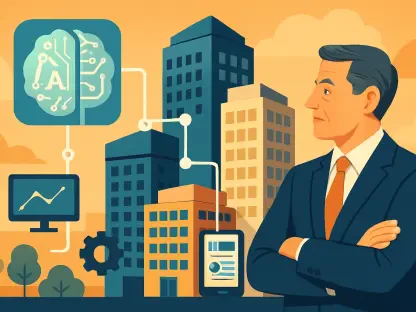In the heart of Northeast Washington, D.C., a massive $705 million project at Ivy City Rail Yard is underway, promising to reshape rail travel along the Northeast Corridor. With millions of passengers relying on Amtrak for efficient and reliable service, the stakes for modernizing rail infrastructure have never been higher, and this roundup dives into diverse perspectives from industry leaders, policymakers, and rail enthusiasts to uncover how this ambitious initiative, alongside broader regional upgrades, could redefine travel experiences. The purpose here is to compile and compare varied opinions and insights on the project’s scope, challenges, and potential to elevate rail service for years to come.
Diverse Perspectives on the Ivy City Project’s Impact
Industry Leaders Weigh In on Modernization Goals
Feedback from rail industry professionals highlights the transformative potential of the Ivy City Rail Yard overhaul. Many emphasize the construction of an 860-foot-long, 260,000-square-foot maintenance facility as a critical step toward enhancing operational efficiency. The facility, equipped with advanced tracks and fueling systems, is seen as a cornerstone for maintaining Northeast Regional trains with greater speed and precision.
Beyond the physical upgrades, industry voices point to the project’s alignment with the introduction of Amtrak’s Airo trainsets by 2027. There’s shared optimism that these next-generation trains, supported by state-of-the-art maintenance hubs, will significantly boost service reliability. However, some caution that the phased construction timeline stretching to 2030 could pose logistical challenges if not managed with precision.
Policymakers Highlight Economic and Social Benefits
Conversations with policymakers reveal a strong focus on the broader implications of this $705 million endeavor. Many view the project as a vital investment in regional connectivity, supported by substantial federal funding of $22 billion from the Infrastructure Investment and Jobs Act. This backing is often cited as evidence of a national commitment to revitalizing rail as a sustainable travel option.
A recurring theme among these discussions is the potential for job creation and economic growth tied to the project. Some policymakers stress that modernized rail infrastructure could attract more passengers, easing road congestion in densely populated areas. Yet, there are concerns about ensuring equitable access to these benefits across diverse communities along the corridor.
Rail Enthusiasts Share Hopes and Concerns
Input from rail enthusiasts and frequent travelers offers a unique grassroots perspective on the Ivy City upgrades. Many express excitement about the promise of enhanced comfort and efficiency with the Airo trainsets, envisioning a future where rail travel rivals air travel in convenience. The prospect of faster inspections and cleaner trains resonates strongly with this group.
However, skepticism exists about whether the project will deliver on its ambitious timeline. Some enthusiasts worry that ongoing construction might lead to service interruptions, despite plans to minimize disruptions. Their insights underscore the importance of transparent communication to keep passengers informed about progress and potential schedule changes.
Comparing Views on Regional Rail Upgrades
Corridor-Wide Improvements: A Unified Vision?
Across various sources, there’s agreement that Ivy City is just one piece of a larger puzzle involving rail yard modernizations in cities like Philadelphia, Boston, and New York City’s Sunnyside Yard, with groundbreaking planned for 2026. Industry professionals often describe these coordinated efforts as essential for creating a seamless travel network across the Northeast.
Policymakers add that projects like the Albany-Rensselaer station redesign in New York further complement this vision, potentially setting a standard for other regions. However, opinions diverge on the pace of implementation, with some highlighting discrepancies in funding allocation as a barrier to uniform progress across these locations.
Enthusiasts, meanwhile, appreciate the ambition but question whether smaller stations will receive adequate attention amid the focus on major hubs. Their input suggests a need for a balanced approach to ensure that upgrades benefit both high-traffic areas and less prominent stops along the corridor.
Challenges of Phased Construction and Passenger Impact
A common thread in discussions is the complexity of executing large-scale construction while maintaining active rail operations. Industry leaders often note that the phased approach through 2030 at Ivy City is designed to limit disruptions, but they acknowledge the risk of unforeseen delays impacting service.
Policymakers tend to focus on the need for robust contingency plans to address potential hiccups during this period. Their perspective emphasizes collaboration between contractors and Amtrak to keep projects on track without compromising passenger experience.
Travelers and enthusiasts, on the other hand, express a practical concern about how these upgrades might affect daily commutes. Many call for detailed updates and alternative travel options during construction phases, reflecting a desire for proactive solutions to mitigate inconvenience.
Funding and Long-Term Sustainability: A Shared Concern
Federal Support as a Game-Changer
The role of federal funding in driving projects like Ivy City garners widespread attention across all groups. Industry professionals frequently praise the $22 billion from the Infrastructure Investment and Jobs Act as a catalyst for nationwide rail renewal, enabling ambitious initiatives that might otherwise stall due to budget constraints.
Policymakers echo this sentiment, often framing the investment as a signal of long-term governmental support for public transportation. They argue that such financial backing could inspire private sector involvement, amplifying the reach of modernization efforts.
However, some rail enthusiasts question whether this funding will be sustained over time, especially in the face of economic or political shifts. Their concerns point to a broader discussion about securing consistent resources to maintain momentum beyond initial project phases.
Workforce and Passenger Benefits in Focus
Another area of consensus is the anticipated positive impact on Amtrak’s workforce and passengers. Industry insights often highlight how modern facilities will streamline maintenance tasks, potentially reducing downtime and improving working conditions for rail staff.
From a policy standpoint, there’s an emphasis on how these upgrades translate to safer, more reliable journeys for travelers. Many in this group advocate for using the project as a model to address infrastructure needs in other transportation sectors.
Enthusiasts add a personal dimension, expressing hope that enhanced service quality will encourage more people to choose rail over other modes of travel. Their views suggest that the ultimate success of Ivy City hinges on tangible improvements felt by everyday passengers.
Reflecting on a Milestone in Rail Modernization
Looking back, the dialogue surrounding the Ivy City Rail Yard modernization paints a vivid picture of optimism tempered by practical challenges. The insights gathered from industry leaders, policymakers, and rail enthusiasts underscore a collective belief in the project’s capacity to elevate Northeast Corridor travel through cutting-edge facilities and the Airo trainsets. For those eager to see the evolution of rail travel firsthand, staying updated via Amtrak’s official channels and engaging with regional transportation forums offers a way to track progress. As this transformative journey unfolds, exploring similar infrastructure projects nationwide provides additional context on how rail could shape sustainable mobility in the years ahead.









